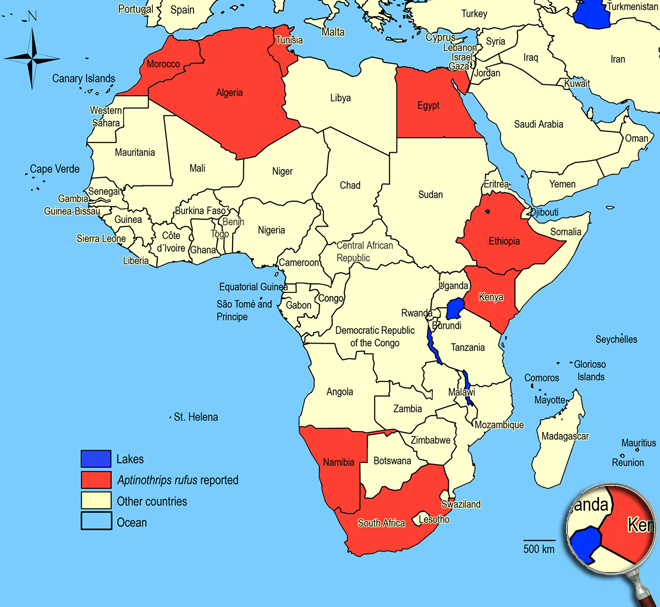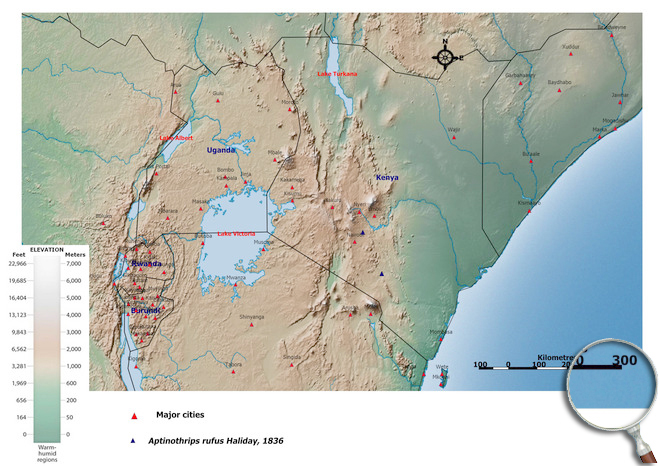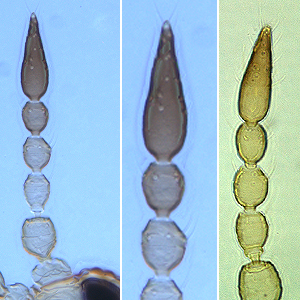Aptinothrips rufus Haliday, 1836
Thripinae, Thripidae, Terebrantia, Thysanoptera
Figures
Fig. 1: 6-segmented antenna, segments IV-VI and II-VI
Fig. 2: Head dorsal, without ocellar triangle
Fig. 3: Pronotum
Fig. 4: Fore leg
Fig. 5: Meso- and metanotum
Fig. 6: Meso- and metasternum
Fig. 7: Tergites IV and V
Fig. 8: Sternites VI and VII
Fig. 9: Tergites VII and VIII
Fig. 10: Tergites VII-XI, with ovipositor
Fig. 11: Tergites IX and X of a male, tergite IX with stout thorn-like setae
Introduction and recognition
Aptinothrips rufus is a grass feeding pest. Both sexes are without wings; body color yellow, antennal segment VI shaded with brown. Antennae 6-segmented; segment VI twice as long as V, III & IV each with simple sense cone (Fig. 1). Head longer than wide; without ocelli or long setae (Fig. 2). Pronotum without long setae (Fig. 3). Meso- and metanotum transversally striate (Fig. 5); mesofurca with median spinula (Fig. 6). Mid and hind tarsi each with one segment (Fig. 4). Fore- and hind wings absent (apterous), Tergites with discal setae variable (2-20); tergite VIII without posteromarginal comb of microtrichia (Fig. 9); tergite IX posteromedian pair of setae short, about 0.2 times as long as lateral pair; tergites and sternites without craspedum (Fig. 10). Sternites with many discal setae; median posteromarginal setae on sternite VII arising in front of margin (Fig. 8).
Male similar to female but smaller; sternites without glandular areas/pore plates; tergite IX with 2 pairs of stout thorn-like setae (Fig. 11).
Taxonomic identity
Species
Aptinothrips rufus Haliday, 1836
Taxonomic history
Aptinothrips groenlandica Richter, 1928
Aptinothrips intermedius Priesner, 1920
Uzelliella lubbocki Bagnall, 1908
Aptinothrips connaticornis Uzel, 1895
Thrips (Aptinothrips) nitidulus Haliday, 1836
Thrips (Aptinothrips) rufus Haliday, 1836
Common name
Grass thrips
Present taxonomic position
Family: Thripidae Stephens, 1829
Subfamily: Thripinae (Stephens) Karny, 1921
Genus: Aptinothrips Haliday, 1836
Genus description
The genus Aptinothrips Haliday, 1836
There are only 4 species in this genus (Palmer 1975), all completely without wings and ocelli. Species of the genus have a mainly yellow body color, head longer than wide, 6- or 8-segmented antennae with simple sense cone on segments III and IV, head and thorax without long setae, mid- and hind tarsi 1- or 2-segmented, and sternites with discal setae. All of the Aptinothrips species are found living in grasses.
Species description
Typical key character states of Aptinothrips rufus Haliday, 1836
Coloration and body sculpture
Body color: mainly pale to yellow, or with some darker markings
Surface of head, pronotum and fore legs: without obvious or with weakly reticulate sculpture
Antennae
Form of sense cones on antennal segments III and IV: emergent and simple on segments III and IV
Number of antennal segments: 6
Antennal segment I: without any setae on dorsal apical margin
Antennal segment II: without an exceptionally long seta at the inner apex
Antennal segment II shape: symmetric
Antennal segments III shape: symmetric
Antennal segments IV and V: without a hyaline ring near the base
Antennal segment VI bears: not a remarkably dagger-shaped sensorium
Length of antennal segment III and IV: antennal segment III similar in length to segment IV
Head
Head: distinctly prolonged in front of compound eyes
Ocellar setae I: absent
Ocelli: absent
Head length to wide: length > width
Length of postocular setae: not alternating short and long setae
Number of ocellar setae: 0
Prothorax
Number of pairs of long anteroangular setae: 0
Number of pairs of long posteroangular setae: 0
Number of pairs of elongate pronotal setae: 0
Pronotal blotch or internal apodeme: absent
Pronotum shape: broadly rectangular
Pronotum posteromarginal/posteroangular setae: S2 longer than S3, not equal in length
Mesothorax
Mesosternal furca: with median spinula
Metathorax
Metanotum with dominant sculptured triangle medially: absent
Metasternal furca: without spinula
Shape of metathoracic furca: transverse, V-shaped
Wings:
Fore and hind wings: absent (apterous)
Legs
Color of fore tarsi: pale or yellow, sometimes apical shaded or brown
Fore tibia: not prolonged around fore tarsus
Mid and hind tarsi: with one segment
Abdomen
Pleurotergites: not covered in microtrichia
Sternite II: with marginal setae and few discal setae
Sternites IV, V and VI: with marginal setae and discal setae medially
Sternite VII median posteromarginal setae S1: arising in front of posterior margin
Sternite VII: with marginal setae and discal setae present on median area
Craspedum on tergites IV to VI: absent
Surface of lateral thirds of abdominal tergites: without regular rows of fine microtrichia
Tergites II to VII median setal pair: no more than 0.3 as long as median length of tergite
Tergites IV and V median setal pair: shorter than distance between their bases
Tergites V to VII: without ctenidia laterally, but sometimes with rows of microtrichia
Tergite VIII ctenidia: without paired ctenidia laterally, sometimes with irregular microtrichia
Tergite VIII posteromarginal comb of microtrichia: absent
Tergite X: not tubular, longitudinally incomplete
Setae on abdominal tergite X: all setae slender

Similar or related species
The long slender head, the 6-segmented antennae with its large terminal segment and simple sense cone on segments III & IV, the lack of long setae on the pronotum, and the 1-segmented tarsi, serve to distinguish this species from any other pale thrips found in grass (Mound & Marullo 1996). Aptinothrips rufus is similar to species of Anaphothrips in having no well-developed setae on head and pronotum and a yellow body color, but species of Anaphothrips have 8- or apparently 9-segmented antennae with forked sense cone on segments III & IV, 2-segmented tarsi, sternites without discal setae, and tergite VIII with a complete posteromarginal comb of microtrichia.
Biology
Life history
As with other thrips species the life cycle from egg to adult is dependent on temperature. The whole life cycle lasts about 40 days (Bailey 1948).
Host plants
Forage grasses (Cynodon dactylon - bermudagrass, Poaceae) and cereal crops (barley, wheat), also French beans.
Weeds: Launaea cornuta.
Vector capacity
None identified, but possible mechanical distribution of phytopathogenic fungi and bacteria.
Damage and symptoms
-
Detection and control strategies
-
Additional notes
Breeding on the leaves of various, but unspecified, grass species, this thrips is sometimes abundant in pastures, but there is little evidence that it damages grass crops.
Biogeography
Throughout the world in temperate climates, including mountains in some tropical countries, cosmopolitan.
Algeria (Sidi Ferruch, Tipasa),
Egypt (Mersa Matruh, Wadi Umm-el-Rakham), Ethiopia (Akaki River, Addis Ababa),
Kenya, Morocco,
Namibia (Windhoek),
South Africa (Gauteng: Pretoria; Western Cape: Strand),
Tunisia (Ferme Shitta - Djebel Eddyr / 1100m).
African countries where Aptinothrips rufus has been reported

Occurence of Aptinothrips rufus in East Africa

Please click here for survey sites of all observed thrips species of Kenya, Tanzania and Uganda.
Click here for locations of Aptinothrips rufus in parts of East Africa.

Bibliography
Bagnall RS (1908). Notes on some genera and species new to the British fauna. Entomologist's Monthly Magazine. 44: 3-7
Bailey SF (1948). Grain and grass-infesting thrips. Journal of Economic Entomology. 41 (5): 701-706
Haliday AH (1836). An epitome of the British genera, in the order Thysanoptera, with indications of a few of the species. The Entomological Magazine. 3 (5): 439-451
Jenser G (1982). Data to the Thysanoptera fauna of Tunisia. Folia Entomologica Hungarica. 43 (1): 55-57
Jenser G (1989). Data to the Thysanoptera fauna of Ethiopia. Acta Zoologica Academiae Scientiarum Hungaricae. 35 (3-4): 205-210
Lewis T (1973). Thrips their: biology, ecology and economic importance. Academic Press Inc., London Ltd., 349 pp
Lewis T (1997). Thrips as crop pests. CAB International, Wallingford, 740 pp
Moritz G (2006). Thripse. Pflanzensaftsaugende Insekten, Bd. 1, (1. Auflage). Westarp, Hohenwarsleben, 384 pp. ISBN-13: 978 3 89432 891 7
Moritz G, Morris DC & Mound LA (2001). ThripsID - Pest thrips of the world. ACIAR and CSIRO Publishing Collingwood, Victoria, Australia, CDROM ISBN 1 86320 296 X
Moritz G, Mound LA, Morris DC & Goldarazena A (2004). Pest thrips of the world - an identification and information system using molecular and microscopical methods. Centre for Biological Information Technology, University of Queensland, Australia, CDROM ISBN 1 86499 781 8
Moritz G, O'Donnell C & Parrella M (2009). Pest thrips of North America. Centre for Biological Information Technology, University of Queensland, Australia, CDROM ISBN-13: 978 1 86499 940 2
Mound LA & Kibby G (1998). Thysanoptera: An identification guide, (2nd edition). CAB International, Wallingford and New York, 70 pp
Mound LA & Marullo R (1996). The thrips of Central and South America: An introduction (Insecta: Thysanoptera). Memoirs on Entomology, International, Vol. 6. Associated Publishers, Gainsville, 487 pp
Mound LA & Walker AK (1982). Terebrantia (Insecta: Thysanoptera). Fauna of New Zealand, No. 1. Science Information Division, DSIR Wellington, New Zealand, 113 pp
Nickle DA (2003). A checklist of commonly intercepted thrips (Thysanoptera) from Europe, the Mediterranean, and Africa at U.S. ports-of-entry (1983-1999). Part I. Key to genera. Proceedings of the Entomological Society of Washington. 105 (1): 80-99
North RC & Shelton AM (1986). Overwintering of the onion thrips, Thrips tabaci (Thysanoptera, Thripidae), in New York. Environmental Entomology. 15 (3): 695-699
Palmer JM (1975). The grass-living genus Aptinothrips Haliday (Thysanoptera: Thripidae). Journal of Entomology, B. 44 (2): 175-188
Pelikán J (1988). Records, notes and list of Thysanoptera from Algeria. Acta Entomologica Bohemoslovaca. 85: 21-27
Priesner H (1920). Beitrag zur Kenntnis der Thysanopteren Oberösterreichs. Jahresbericht des Museum Francisco-Carolinum. 78: 50-63
Priesner H (1926-28). Die Thysanopteren Europas. F. Wagner Verlag, Wien, 755 pp
Priesner H (1938). Contributions towards a knowledge of the Thysanoptera of Egypt, XI. Bulletin de la Société Royale Entomologique d´Égypte. 21: 208-222
Priesner H (1964). A monograph of the Thysanoptera of the Egyptian deserts. Publications de ľInstitut du Desert d´Égypte (1960). 13: 1-549
Richter W (1928). Die Thysanopteren des arktischen Gebietes. Fauna Arctica. 5 (3): 837-885
Sharga US (1933). Biology and life history of Limothrips cerealium Haliday and Aptinothrips rufus Gmelin feeding on Gramineae. Annals of Applied Biology. 20: 308-326
Speyer ER (1935). The genus Aptinothrips Haliday (Thysanoptera: Terebrantia). Transactions of the Royal Entomological Society of London. 83 (4): 483-508
Stannard LJ (1968). The thrips, or Thysanoptera, of Illinois. Illinois Natural History Survey Bulletin. 29 (4): 214-552
Uzel H (1895). Monographie der Ordnung Thysanoptera. Uzel, Königgrätz, 473 pp
zur Strassen R (1960). Catalogue of the known species of South African Thysanoptera. Journal of the Entomological Society of Southern Africa. 23 (2): 321-367
zur Strassen R (1968). Ökologische und zoogeographische Studien über die Fransenflügler-Fauna (Ins., Thysanoptera) des südlichen Marokko. Abhandlungen der Senkenbergischen Naturforschenden Gesellschaft. 515: 1-125
zur Strassen R (1983). Thysanopterologische Notizen (6) (Insecta: Thysanoptera). Senckenbergiana Biologica. 63 (3-4): 191-209
zur Strassen R (2003). Die terebranten Thysanopteren Europas und des Mittelmeer-Gebietes. Die Tierwelt Deutschlands und der angrenzenden Meeresteile nach ihren Merkmalen und nach ihrer Lebensweise, 74. Teil. Goecke & Evers, Keltern, Germany, 277 pp
----
Web links
Mound´s Thysanoptera pages
Thysanoptera Checklist
ICIPE Thrips survey sites
UNI Halle & Thrips sites
Thrips of California















